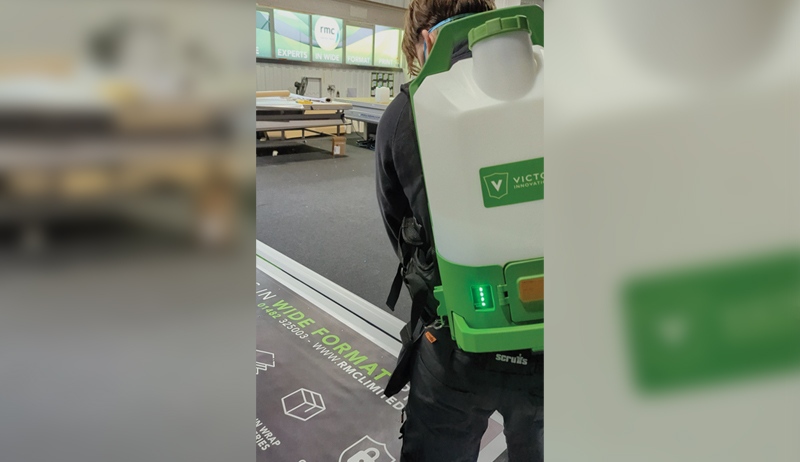You may have heard that Hollywood Monster and Octink are using an anti-pollution system called Clean Air on some of their outdoor print. Now RMC Digital Print has started offering it to clients too. So should you join their gang?
Pretty much every breath you take has pollutants in it. Nicole Spencer, MD at RMC Digital Print, hopes a decision to invest in Clean Air technology from PrintHubGlobal will reduce those resting on the outdoor print it provides to clients.
To date, the Hull-based trade print provider, along with Hollywood Monster and Octink, are the only print companies in the UK to be using the Clean Air technology (see siderbar), developed in a joint venture between PrintHubGlobal and a company called Resysten, which makes photocatalytic protective coatings. But PrintHubGlobal commercial director Steve Lewis is reading to roll-out the solution across the wider print industry - and others, such as the construction sector where it will be used on the graphics outside building sites as well as inside new builds.
The panel below explains how Clean Air works in more depth, but basically, it gets rid what Lewis calls “the killer” pollutants in the air - such as NO2 and VOCs - so by spraying the solution on outdoor prints, it actually helps do what the name says - clean the air in the vicinity. It’s of benefit all round, as Spencer explains.
“Last year we committed to reducing our carbon footprint and aiming for net zero within the next five years. We have been working with a local initiative OH Net Zero to achieve this. As part of this project, we have installed solar panels, replaced our lighting with LEDs and worked with Fespa UK and Reconomy to recycle our waste so nothing goes to landfill. We’ve also changed company cars for electric ones and installed charging points, as well as encouraging our staff to look into replacing their cars with electric ones through a government scheme we have joined. Another focus has been to look at changing our substrates to more environmentally friendly alternatives.
“We’re always on the lookout for products that will be kinder to the environment so when we were approached by Clean Air we were interested in the product and the reduction in pollution it offers. We spoke with a few clients about it and had positive feedback. Then we had a client approach us to use it on a particular job so we committed to investing in the technology and kit. We’ve only just started using it and need to make our clients aware of the benefits.
“The spray can be used on any of the substrates we print so the possibilities for reduction in pollution are vast. The guys at Clean Air explained that 50m2 of the product offsets the equivalent emission of your average family car per year per day. As an industry that are often seen to be contributing to pollution and waste it is nice to be able to make a positive change.
“We’re hoping that more clients will see the benefit of reducing pollution and use the solution on their outdoor prints. We provide thousands of flex face skins for retail parks up and down the country every year so spraying all of them would see a real reduction in pollution.”
How it works
In a nutshell, Clean Air is a colourless and odourless coating that actively breaks down harmful pollutants at a local level through a process of photocatalytic oxidation - a process in which light energy is used to drive chemical reactions.
The coating absorbs the ultraviolet component of light, acting as a catalyst to form reactive hydroxyl (OH) radicals in the presence of atmospheric moisture. These radicals can oxidize and destroy most pollutant molecules, thus reducing the impact of VOC emissions as well as NH3, N2O, CO2, and CH4. Each square meter of photocatalytic material, exposed to outdoor sunlight, can remove nitrogen oxides from about 200m3 of air per day.
Clean Air can be applied to any surface, including print, using special spraying tanks. It remains active on surfaces for a minimum of one year according to its supplier PrintHubGlobal and can be measured to ensure effectiveness and performance. It has been proven to work best at street level where pollution is at its highest - so on buildings, vehicles, street furniture and signage etc.
As PrintHubGlobal commercial director Steve Lewis explains, photocatalysis is not in itself new in terms of its anti-microbial capability, but getting the necessary chemicals used in the process to stick to surfaces long enough to remain an active environmental purifier has been the game changer.
“The use of titanium dioxide as a photocatalyst has been around over 40 years, but as soon as a surface was wiped it would be wiped away too,” says Lewis. “But a few years ago Resysten developed a binder that could keep it on a surface for 12 months or more. In talking with them we began to see the potential for the technology to clean air, not just surfaces, so we did a joint venture and a year ago we brough Clean Air to market - having sourced the Victory Spray Gun to allow it to be sprayed onto print.
“We have been testing it at Queens University in Belfast, which has a specialist coatings facility, and with a small initial group of printers. Now that we know its efficacy we are about to start rolling it out more widely.”


